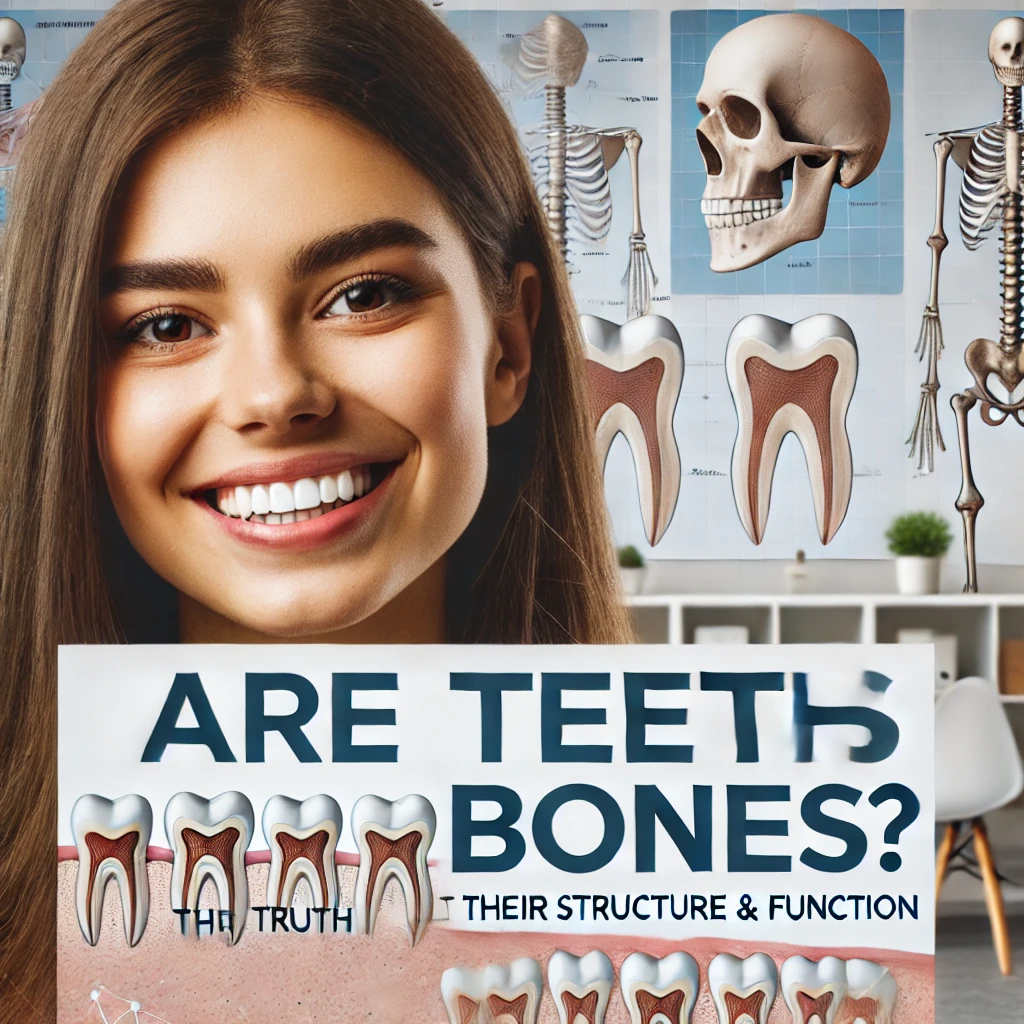Introduction
Many people assume that teeth are bones due to their hardness and white appearance. However, while teeth and bones share some similarities, they are fundamentally different in structure, function, and composition. Understanding these differences is crucial for maintaining proper oral health and preventing long-term dental issues.
In this comprehensive guide, we will explore the composition of teeth, how they differ from bones, their unique functions, and the best ways to care for them for lifelong dental health.
What Are Teeth Made Of?
Unlike bones, which consist primarily of collagen and calcium phosphate, teeth are composed of several distinct layers that contribute to their durability and function. These include:
1. Enamel
- The outermost layer of the tooth.
- Harder than bone and the hardest substance in the human body.
- Composed mainly of hydroxyapatite, a crystalline form of calcium phosphate.
- Provides protection against physical and chemical damage.
2. Dentin
- The middle layer beneath the enamel.
- Softer than enamel but still harder than bone.
- More susceptible to decay when exposed.
3. Pulp
- The innermost part of the tooth.
- Contains nerves, blood vessels, and connective tissue.
- Essential for providing nutrients and sensory function to the tooth.
4. Cementum
- A thin layer of calcified tissue covering the root of the tooth.
- Helps anchor the tooth to the jawbone via the periodontal ligament.
While teeth are made of calcium-based materials, they lack the bone marrow that bones contain, making them structurally and functionally distinct from bones.
How Are Teeth Different from Bones?
Although teeth and bones have similar components, they differ in various ways:
| Feature | Teeth | Bones |
| Composition | Enamel, dentin, pulp, cementum | Collagen, calcium phosphate |
| Regeneration | Cannot heal or regenerate | Can heal and regenerate |
| Marrow | No marrow present | Contains bone marrow |
| Function | Chewing, breaking down food | Structural support, mineral storage, blood production |
| Blood Supply | Limited to pulp | Rich blood supply in bone marrow |
These differences highlight why tooth damage is often permanent, whereas bones have the ability to heal over time.
Why Teeth Are Not Considered Bones
Despite being rich in minerals and hard in texture, teeth are not classified as bones due to the following reasons:
- Teeth Do Not Regenerate – Bones have the ability to heal from fractures, whereas teeth cannot repair themselves once damaged.
- Teeth Lack Bone Marrow – Unlike bones, teeth do not produce blood cells or store minerals.
- Different Growth and Development – Bones grow and remodel throughout life, while teeth remain the same once they erupt.
- Vascularization Differences – Bones have an extensive blood supply through bone marrow, while teeth rely on limited blood flow through the pulp.
Functions of Teeth vs. Bones
Functions of Teeth
- Chewing and Breaking Down Food – Essential for digestion.
- Speech and Communication – Helps in pronunciation and clarity of speech.
- Aesthetic and Facial Structure – Contributes to facial appearance and confidence.
Functions of Bones
- Structural Support – Provides the framework for muscles and organs.
- Mineral Storage – Stores calcium and phosphorus for metabolic processes.
Common Misconceptions About Teeth and Bones
1. Teeth and Bones Have the Same Strength
- Fact: Enamel is harder than bone, but bones are more resilient because they can regenerate.
2. Calcium Alone Keeps Teeth Healthy
- Fact: While calcium is essential, other nutrients like phosphorus, vitamin D, and fluoride play key roles in dental health.
3. Brushing Harder Makes Teeth Cleaner
- Fact: Brushing too hard can wear down enamel and cause gum recession, leading to sensitivity and decay.
4. Teeth Whitening Damages Enamel
- Fact: Professional whitening treatments are safe when done correctly, but overuse of harsh whitening agents can erode enamel over time.
Best Practices for Keeping Teeth Healthy
Since teeth cannot regenerate like bones, proper dental care is crucial to maintaining their longevity. Here are essential oral hygiene tips:
1. Brush and Floss Daily
- Use a fluoride toothpaste to strengthen enamel.
- Brush twice a day using a soft-bristled toothbrush.
- Floss daily to remove plaque between teeth.
2. Eat a Tooth-Friendly Diet
- Limit sugary and acidic foods that contribute to enamel erosion.
- Drink plenty of water to rinse away bacteria.
3. Regular Dental Checkups
- Visit a dentist every six months for professional cleanings.
- Get X-rays to detect hidden cavities or gum disease.
- Consider sealants and fluoride treatments for added protection.
4. Avoid Harmful Habits
- Do not use teeth as tools (e.g., opening bottles or biting nails).
- Avoid excessive coffee, soda, and tobacco that stain and weaken enamel.
- Wear a mouthguard when playing contact sports to prevent tooth fractures.
Conclusion
Although teeth and bones share similarities, they are fundamentally different in structure and function. Teeth lack the regenerative capabilities of bones, making oral care and preventive measures even more essential. By understanding these differences and practicing good oral hygiene, you can maintain strong and healthy teeth for a lifetime.
The next time someone asks, “Are teeth bones?” you’ll have the perfect answer! Teeth are not bones—they are a unique and vital part of human anatomy that requires specialized care to stay healthy and functional.



